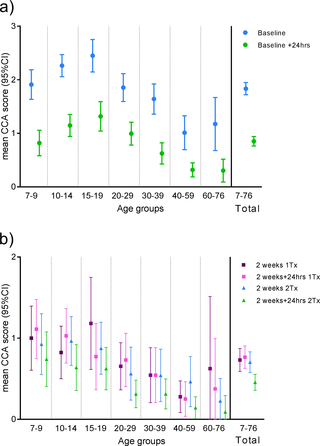PLOS Neglected Tropical Diseases ( IF 3.4 ) Pub Date : 2017-11-13 , DOI: 10.1371/journal.pntd.0006054 Anna O. Kildemoes , Birgitte J. Vennervald , Edridah M. Tukahebwa , Narcis B. Kabatereine , Pascal Magnussen , Claudia J. de Dood , André M. Deelder , Shona Wilson , Govert J. van Dam

|
Schistosomiasis control and elimination has priority in public health agendas in several sub-Saharan countries. However, achieving these goals remains a substantial challenge. In order to assess progress of interventions and treatment efficacy it is pertinent to have accurate, feasible and affordable diagnostic tools. Detection of Schistosoma mansoni infection by circulating cathodic antigen (CCA) in urine is an attractive option as this measure describes live worm infection noninvasively. In order to interpret treatment efficacy and re-infection levels, knowledge about clearance of this antigen is necessary. The current study aims to investigate, whether antigen clearance as a proxy for decreasing worm numbers is reflected in decreasing CCA levels in urine shortly after praziquantel treatment. Here CCA levels are measured 24 hours post treatment in response to both a single and two treatments. The study was designed as a series of cross-sectional urine and stool sample collections from 446 individuals nested in a two-arm randomised single blinded longitudinal clinical trial cohort matched by gender and age (ClinicalTrials.gov Identifier: NCT00215267) receiving one or two praziquantel treatments. CCA levels in urine were determined by carbon-conjugated monoclonal antibody lateral flow strip assay and eggs per gram faeces for S. mansoni and soil-transmitted helminths by Kato-Katz. Significant correlations between CCA levels and S. mansoni egg count at every measured time point were found and confirmed the added beneficial effect of a second treatment at two weeks after baseline. Furthermore, presence of hookworm was found not to be a confounder for CCA test specificity. Twenty-four hours post treatment measures of mean CCA scores showed significant reductions. In conclusion, removal of CCA in response to treatment is detectable as a decline in CCA in urine already after 24 hours. This has relevance for use and interpretation of laboratory based and point-of-care CCA tests in terms of treatment efficacy and re-infection proportions as this measure provides information on the presence of all actively feeding stages of S. mansoni, which conventional faecal microscopy methods do not accurately reflect.
Trial registration
ClinicalTrials.gov NCT00215267
中文翻译:

乌干达捕捞社区尿试纸条显示治疗后曼氏血吸虫循环阴极抗原的快速清除–监测治疗效果和再感染的相关性
在几个撒哈拉以南国家,控制和消除血吸虫病在公共卫生议程中具有优先地位。但是,实现这些目标仍然是一个巨大的挑战。为了评估干预措施的进展和治疗效果,必须拥有准确,可行和负担得起的诊断工具。曼氏血吸虫的检测尿液中循环阴极抗原(CCA)感染是一种有吸引力的选择,因为该措施无创地描述了蠕虫感染。为了解释治疗效果和再感染水平,需要有关该抗原清除的知识。目前的研究旨在调查在吡喹酮治疗后不久尿液中CCA水平降低是否反映出抗原清除作为蠕虫数量减少的代名词。在此,响应于一次和两次治疗,在治疗后24小时测量CCA水平。该研究被设计为来自446个个体的一系列横断面尿液和粪便样本,这些个体嵌套在按性别和年龄相匹配的两臂随机单盲纵向临床试验队列中(ClinicalTrials.gov标识符:NCT00215267)接受一种或两种吡喹酮治疗。尿液中的CCA水平通过碳缀合的单克隆抗体侧流试纸法测定,每克粪便中的卵数为小号。曼陀罗和加藤·卡兹(Kato-Katz)传播的土壤蠕虫。CCA水平与S之间有显着的相关性。曼索尼发现每个测量时间点的卵数,并确认基线后两周进行第二次治疗的附加有益效果。此外,发现钩虫并不是CCA测试特异性的混杂因素。治疗后二十四小时的平均CCA评分显示明显降低。总之,由于治疗24小时后尿液中CCA下降,因此可以检测到因治疗而导致的CCA去除。就治疗功效和再感染比例而言,这与使用和解释基于实验室的和即时护理CCA测试有关,因为该方法可提供有关S的所有主动进食阶段的存在的信息。传统的粪便显微镜方法无法准确反映曼氏。
试用注册
ClinicalTrials.gov NCT00215267











































 京公网安备 11010802027423号
京公网安备 11010802027423号